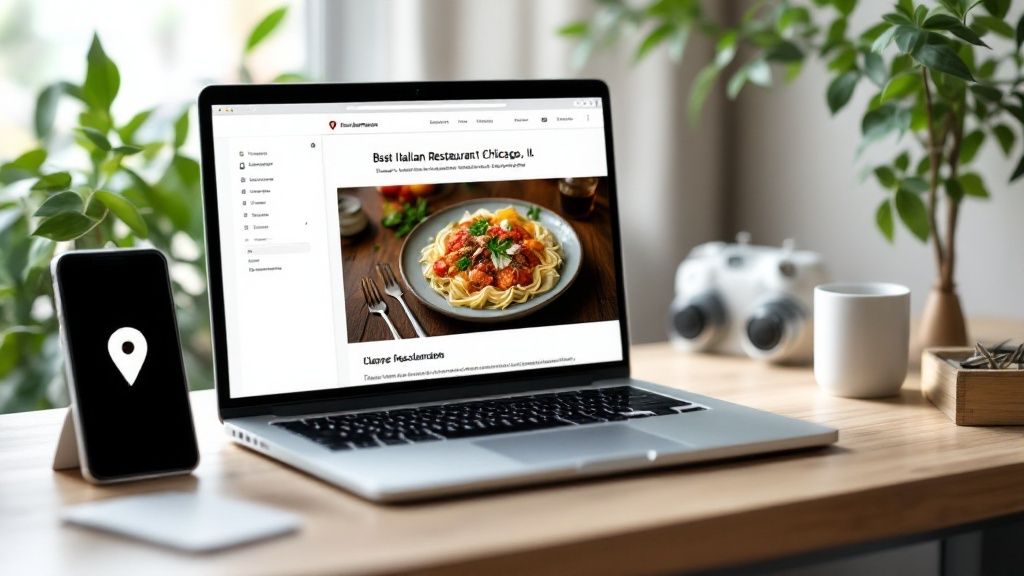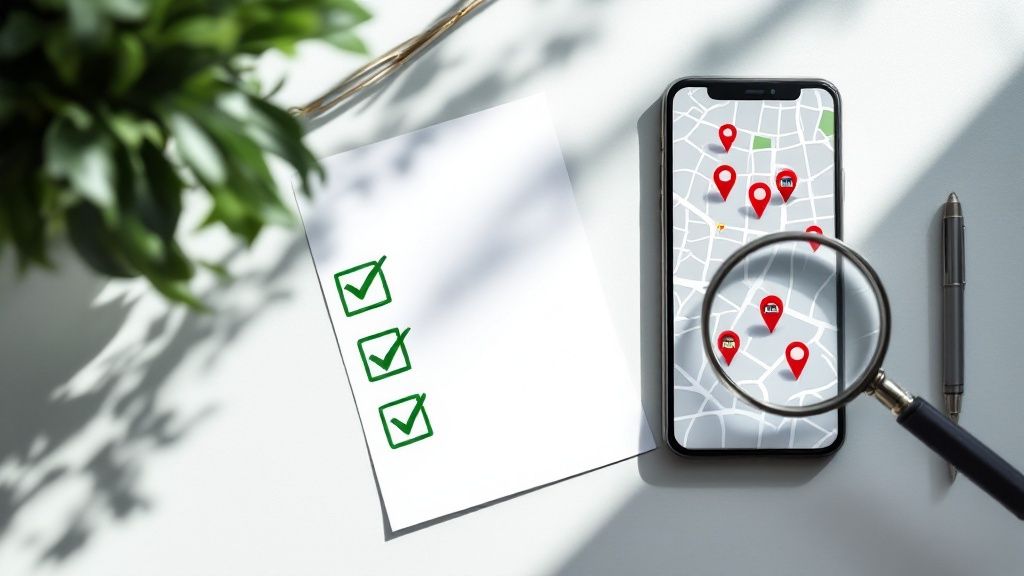Dominate Your Local Search Rankings
Want more local customers? This local SEO checklist provides seven actionable steps to boost your online visibility and attract nearby business. Learn how to optimize your Google Business Profile, conduct local keyword research, implement on-page SEO best practices, build local citations, manage online reviews, build local links, and create a local content marketing strategy. Following this local SEO checklist will help your business thrive in your local market.
1. Google Business Profile Optimization
Optimizing your Google Business Profile (GBP), formerly Google My Business, is the cornerstone of any effective local SEO checklist. It's your business's digital storefront on Google, influencing how you appear in local search results and on Google Maps. A well-optimized GBP helps potential customers find your business, learn crucial details, and ultimately choose you over the competition. This involves creating, claiming, or updating your existing listing with accurate and comprehensive information. Doing so maximizes your visibility and establishes a direct communication channel with your customer base.

The infographic above visualizes the process of optimizing your Google Business Profile, highlighting the key areas to focus on. It starts with claiming or creating your profile and moves through crucial optimization steps like adding photos, choosing categories, and gathering reviews.
The process of GBP optimization is crucial for local SEO success and follows a specific flow for best results. The key steps illustrated in the infographic include: Claiming and Verifying Your Listing, Optimizing Business Information (NAP), Selecting Relevant Categories, Adding Engaging Photos and Videos, Encouraging and Responding to Customer Reviews, and Regularly Updating Your Profile with Fresh Content. The sequential nature of these steps ensures a comprehensive and effective optimization strategy. Skipping steps can hinder your profile's performance and limit its reach.
This process underscores the importance of treating your GBP listing as a dynamic entity requiring ongoing attention. Each step builds upon the previous one, culminating in a complete and engaging profile that attracts customers and boosts your online presence. The infographic clearly demonstrates that GBP optimization isn't a one-time task, but an ongoing effort to keep your information accurate and engaging.
Features of a Google Business Profile:
- Business Information Verification: Ensures data accuracy and builds trust.
- Category Selection: Helps Google understand your business and connect you with relevant searches.
- Service Area Definition: Specifies the geographic area you serve.
- Photo and Video Uploads: Showcases your business, products, and services visually.
- Q&A Management: Allows you to address customer queries directly.
- Review Management: Facilitates interaction with customer feedback.
Pros:
- Free to Use: Leveraging GBP is cost-effective.
- Directly Influences Local Pack Rankings: A well-optimized profile improves visibility in the "local pack" (the top three results displayed for local searches).
- Improves Visibility on Google Maps: Makes it easier for customers to locate your business physically.
- Provides Direct Customer Interaction Channels: Facilitates communication through reviews, Q&A, and messaging.
- Offers Analytics on Search Performance: Provides insights into how customers find and interact with your profile.
Cons:
- Susceptible to Review Bombing: Negative reviews can impact your reputation.
- Can be Hijacked if Not Properly Secured: Requires vigilance to prevent unauthorized access and changes.
- Limited Customization Options: Design flexibility is restricted within Google's framework.
- Changes May Take Time to Be Approved: Updates aren't always instantaneous.
Examples of Successful GBP Optimization:
- Starbucks: Maintains consistent GBP listings across thousands of locations with accurate hours and services.
- Home Depot: Uses GBP features to highlight specific departments and in-store inventory.
Actionable Tips for Optimizing Your Google Business Profile:
- Use a local phone number rather than a toll-free one.
- Select the most specific primary category possible.
- Add all relevant secondary categories.
- Post updates at least twice monthly.
- Respond to all reviews, both positive and negative.
- Ensure NAP (Name, Address, Phone) consistency with your website.
- Add attributes relevant to your business (e.g., "wheelchair accessible," "free WiFi").
Google Business Profile optimization deserves a top spot on any local SEO checklist because it's a fundamental tool for driving local visibility and engagement. By leveraging this free and powerful platform, businesses can connect with potential customers directly, improve their search rankings, and ultimately grow their bottom line. This approach is crucial for any business with a physical location or serving a specific geographic area. Businesses popularizing best practices for GBP optimization include Google itself, Moz Local, and BrightLocal.
2. Local Keyword Research & Implementation
Local keyword research and implementation is the cornerstone of any successful local SEO checklist. It's the process of identifying the specific terms your potential customers use when searching for businesses like yours within your local area, and then strategically integrating those keywords into your website content. This is crucial because it signals to search engines that your business is relevant to local searches, boosting your visibility in local search results. Effective local keyword research goes beyond simply including your city name; it requires understanding the nuances of local search behavior.

This approach hinges on several key features: geo-modified keyword targeting (e.g., "bakery in San Francisco"), long-tail local search phrases (e.g., "best gluten-free cupcakes near Fisherman's Wharf"), service-area specific keyword variations (e.g., "wedding cake delivery Marin County"), and neighborhood and landmark targeting (e.g., "cakes near Golden Gate Park"). By incorporating these elements, you can precisely target customers who are actively looking for your products or services in your specific locale.
This strategy offers several distinct advantages. It allows you to target customers with high purchase intent, meaning they're actively searching for something you offer right now. Local keywords are also typically less competitive than broader national keywords, making it easier for smaller businesses to rank well. Furthermore, local keyword implementation significantly improves your relevance for local searches, driving more targeted traffic to your site. Finally, it's highly adaptable, allowing you to tailor your keyword strategy to specific service areas or neighborhoods.
While incredibly effective, local keyword research does have some potential drawbacks. The search volume for hyper-local terms can sometimes be limited, especially for highly niche businesses. It also requires ongoing research as local terminology and search trends evolve. And finally, if not done creatively, incorporating local keywords can become repetitive and feel unnatural, potentially harming your user experience.
For instance, a plumber in Boston might use keywords like "emergency plumber Boston" and "Back Bay pipe repair" strategically throughout their website. Similarly, law firms can benefit from targeting terms like "personal injury lawyer [city]" alongside variations that include specific neighborhoods.
Actionable Tips for Implementing Local Keywords:
- Include location variations: Use a variety of location modifiers, including city, neighborhood, ZIP code, and even nearby landmarks.
- Create location pages: If you serve multiple areas, create dedicated location pages with unique content tailored to each specific location.
- Leverage "People also ask": Use Google's "People also ask" feature to uncover common local search queries related to your business.
- Natural keyword integration: Incorporate keywords naturally within your page titles, headings, body content, and meta descriptions.
- Consider seasonal trends: Think about seasonal local search trends, such as "holiday events in [city]" or "best summer camps in [neighborhood]".
- Use keyword research tools: Utilize tools like SEMrush or Ahrefs with location modifiers to identify relevant local keywords and track their performance.
Local keyword research and implementation deserves its place on any local SEO checklist because it directly connects your business with customers actively searching for what you offer in your area. By understanding and implementing this critical strategy, you can significantly improve your local online visibility, attract more targeted traffic, and ultimately drive more business. You might find this article about the differences between B2B and B2C marketing relevant as you consider how best to Learn more about Local Keyword Research & Implementation and connect with your local audience. Methods popularized by SEO authorities like Moz, Yoast SEO, and BrightLocal further solidify the importance of this practice.
3. On-Page Local SEO Optimization
On-page local SEO is a critical aspect of any local seo checklist. It involves optimizing individual website pages to rank higher in local search results. By making these pages more relevant and authoritative for location-specific queries, you increase your visibility to potential customers searching for businesses like yours in their area. This process encompasses both technical elements, such as schema markup, and content optimization strategies focused on local intent. It's about sending clear signals to search engines that your business serves a specific geographic area and matching the needs of users seeking local products or services.

Features of effective on-page local SEO include location-specific title tags and meta descriptions, localized header tags (H1, H2, etc.), schema markup for local businesses, internal linking between location pages, and, critically, mobile optimization. Think of it as building a comprehensive online storefront that is easily discoverable by both search engines and potential customers.
This approach deserves a prominent place on any local SEO checklist because it directly communicates location relevance to search engines. This leads to improved click-through rates from search results by showing searchers that your business is located where they are searching. It also enhances user experience for local searchers by providing the precise information they need, like address, phone number, and hours of operation. Furthermore, many on-page optimizations are relatively easy to implement and control, offering businesses a tangible way to improve their local search visibility.
Examples of Successful Implementation:
- Home Depot: Creates unique, optimized pages for each store location, often featuring local inventory information. This allows customers to easily find the closest store and check product availability before visiting.
- Domino's Pizza: Implements store locator pages with rich local content and online ordering capabilities, streamlining the customer journey from search to purchase.
Pros:
- Directly communicates location relevance to search engines.
- Improves click-through rates from search results.
- Enhances user experience for local searchers.
- Relatively easy to implement and control.
Cons:
- Requires regular updates as business information changes.
- Can be time-consuming for multi-location businesses.
- Must balance SEO with user experience.
Actionable Tips:
- Include city and state in title tags (e.g., 'Best Italian Restaurant | Chicago, IL').
- Implement LocalBusiness schema markup with accurate NAP (Name, Address, Phone Number) information.
- Create a dedicated 'Contact' page with an embedded Google Map.
- Ensure mobile responsiveness for all location pages.
- Include location-specific testimonials on service area pages.
- Add landmarks and neighborhoods to content where relevant (e.g., "Near Wrigley Field").
- Optimize image alt text with location terms.
When and Why to Use On-Page Local SEO:
On-page local SEO should be a continuous effort for any business with a physical location or serving a specific geographic area. It is essential for attracting local customers through online search, especially for businesses reliant on foot traffic or local deliveries. Learn more about On-Page Local SEO Optimization to delve deeper into these strategies. By meticulously optimizing each page, you ensure your business appears prominently in local search results, connecting you with the customers actively searching for your products or services in their area. Don't just be present online, be prominent locally.
4. Local Citation Building & Management
Local citation building and management is a crucial aspect of any local SEO checklist. It involves creating and maintaining consistent online mentions of your business's name, address, and phone number (NAP) across various directories, websites, and social platforms. This process is essential for building your online presence, improving local search rankings, and driving more customers to your business. In a nutshell, citations act as online signals that help search engines verify your business's existence and legitimacy, ultimately influencing where you rank in local search results.
How it Works:
Search engines like Google use citations as a key factor in determining which businesses to display in local search results (like the "local pack" or map listings). Consistent NAP information across numerous reputable sources signals to search engines that your business is legitimate and trustworthy. Moreover, citations provide additional avenues for potential customers to discover your business beyond just your website and social media profiles.
Examples of Successful Implementation:
- A dentist ensuring consistent NAP information across dental-specific directories like DentistDirectory.com (if it existed) and general platforms like Yelp, builds trust and improves visibility within the dental community and among local searches.
- Target maintaining identical store information (including NAP, hours of operation, etc.) across Yelp, Facebook, Foursquare, and Yellow Pages ensures customers can easily find the correct information no matter where they search.
Actionable Tips for Readers:
- Start with major platforms: Create or claim your listings on Google Business Profile (essential!), Yelp, Facebook, Apple Maps, and Bing Places.
- Focus on quality over quantity: A few high-quality citations on reputable platforms are more valuable than numerous low-quality listings on obscure sites.
- Prioritize industry and location-specific directories: Look for directories relevant to your industry and local area to reach a targeted audience.
- Use a spreadsheet to track all citation sources: This helps you stay organized and monitor your citation building efforts.
- Consider citation management tools for efficiency: Tools like Whitespark, BrightLocal, and Yext can automate some of the citation building and management process.
- Audit citations regularly for consistency: Ensure your NAP information is accurate and up-to-date across all platforms.
- Remove or correct duplicate listings: Duplicate listings can confuse search engines and harm your local SEO efforts.
When and Why to Use This Approach:
Local citation building and management should be an ongoing effort for any business that serves a local customer base. It's particularly important for businesses with physical locations that rely on local foot traffic. This approach is essential for:
- Improving local search rankings: Consistent citations are a strong ranking signal for local SEO.
- Building online visibility: Citations create more opportunities for customers to find your business online.
- Establishing credibility and trust: Consistent NAP information across multiple platforms signals legitimacy to both search engines and potential customers.
Pros:
- Builds trust with search engines
- Improves local search rankings
- Creates additional pathways for customers to find your business
- Helps validate business legitimacy
Cons:
- Time-consuming to manage manually
- Can be costly if using premium citation services
- Difficult to update information across all platforms when business details change
Why This Item Deserves Its Place in the List:
Local citation building and management is a foundational element of local SEO. Without consistent and accurate citations, your business risks losing visibility in local search results and missing out on potential customers. It directly impacts your ability to rank well in local searches, build trust with search engines, and attract local customers. This makes it a must-have on any comprehensive local SEO checklist.
5. Review Generation & Management Strategy
A robust review generation and management strategy is crucial for any business aiming to succeed in local SEO. This systematic approach encompasses encouraging, collecting, and responding to customer reviews across various platforms like Google, Yelp, and other industry-specific review sites. Why is this so important for your local SEO checklist? Because reviews significantly impact local search rankings and heavily influence consumer decision-making. Positive reviews act as social proof, boosting your credibility and encouraging potential customers to choose your business over competitors.
This strategy involves several key features:
- Review acquisition processes: Developing streamlined methods for requesting reviews from satisfied customers.
- Response templates and protocols: Crafting pre-written responses to address common feedback, while ensuring each reply maintains a personalized touch.
- Review monitoring across platforms: Tracking reviews across all relevant platforms to stay informed about customer sentiment and identify areas for improvement.
- Reputation management: Addressing negative reviews promptly and professionally to mitigate their impact and demonstrate a commitment to customer satisfaction.
- Review snippet schema implementation: Using schema markup on your website to help search engines understand and display your review data more effectively in search results.
Let's explore the advantages and disadvantages of implementing a review generation and management strategy:
Pros:
- Directly influences local pack rankings: Google considers review quantity, quality, and recency as ranking factors for local search results.
- Builds consumer trust and credibility: Positive reviews build trust and demonstrate the value your business provides.
- Provides valuable business feedback: Reviews offer insights into customer experiences, highlighting areas of strength and weakness.
- Improves click-through rates from search results: Positive reviews make your business listing more attractive, increasing the likelihood of clicks.
Cons:
- Negative reviews can damage reputation: Negative reviews, if left unaddressed, can harm your online reputation.
- Time-consuming to manage across multiple platforms: Monitoring and responding to reviews on multiple platforms can require significant time and effort.
- Some review platforms have strict solicitation policies: Be aware of and adhere to each platform's guidelines for requesting reviews.
- Difficult to maintain consistency in review generation: Consistently acquiring reviews requires ongoing effort and engagement.
Actively encouraging reviews is crucial for building a strong online presence. Check out these strategies to get more customer reviews from Testimonial Donut.
Businesses like Zappos exemplify successful review management by consistently responding to all reviews within 24 hours with personalized responses. Similarly, The Ritz-Carlton has implemented post-stay email campaigns that have generated a significant increase in reviews, showcasing the effectiveness of proactive review generation.
Actionable Tips for Your Local SEO Checklist:
- Create a standardized process: Develop a clear process for asking satisfied customers for reviews, making it easy and convenient for them to share their experiences.
- Respond promptly: Respond to all reviews, both positive and negative, within 48 hours. Timely responses demonstrate responsiveness and show customers you value their feedback.
- Use templates, but personalize: Create review response templates to streamline the process while still personalizing each response to address the specific feedback provided.
- Centralize monitoring: Use review management software to centralize review monitoring across all platforms, simplifying the process and ensuring no review goes unnoticed.
- Train your staff: Train your staff on how to naturally request reviews at key service touchpoints, creating opportunities for organic review generation.
- Implement review schema: Implement review schema markup on your website to enhance the visibility of your reviews in search results.
- Consider automation: Consider using SMS or email automation for review requests, streamlining the process and increasing efficiency.
By incorporating a well-defined review generation and management strategy into your local SEO checklist, you can leverage the power of customer feedback to enhance your online reputation, attract new customers, and ultimately boost your local search rankings.
6. Local Link Building Strategy
A robust local SEO checklist wouldn't be complete without a dedicated local link building strategy. This involves acquiring high-quality backlinks from trusted sources within your specific community and industry, emphasizing geographic relevance over pure domain authority. While national SEO often prioritizes high-authority backlinks from major websites, local link building focuses on connections within your city or region. This tells search engines that your business is a relevant and active part of the local community, boosting your visibility in local search results. This is crucial for any business targeting local customers, as it helps them appear higher in search results for location-based queries.
How It Works:
Local link building works by creating a network of local citations and references to your business online. Search engines interpret these links as votes of confidence from your community, strengthening your local SEO authority. This is particularly important for ranking in the "local pack," the prominent box at the top of search results displaying top local businesses for a given search.
Features of a Successful Local Link Building Strategy:
- Community sponsorships and partnerships: Sponsoring local events or partnering with community organizations offers opportunities for backlinks from their websites and potential media coverage.
- Local press coverage: Getting featured in local newspapers, blogs, or online publications provides valuable backlinks and enhances your local reputation.
- Chamber of Commerce membership: Joining your local Chamber of Commerce often comes with a directory listing and potential link opportunities.
- Local event participation: Attending and participating in local events, conferences, or workshops can lead to networking opportunities and potential backlinks.
- Industry association affiliations: Joining relevant industry associations within your locale can provide access to member directories and link opportunities.
Pros:
- Builds local relevance signals for search engines: This is crucial for ranking higher in local search results.
- Creates community relationships and brand awareness: Engaging with your community builds trust and recognition.
- Often easier to acquire than national links: Local connections are often more accessible than securing links from national publications.
- Drives locally targeted referral traffic: Links from local sources bring in relevant traffic from your target area.
Cons:
- Limited scaling potential compared to national SEO: The focus is narrow, which limits the overall reach.
- Can require significant community involvement: Building local relationships requires time and effort.
- May have higher time investment relative to link value: Some local links may not carry the same weight as high-authority national links.
- Some local links may have lower domain authority: While relevance is key, some local sites may have lower DA than national counterparts.
Examples of Successful Implementation:
- A restaurant sponsors local youth sports teams and receives links from the team websites, as well as local news coverage of their sponsorship.
- A law firm creates scholarship programs for local universities, generating valuable .edu backlinks and positive community recognition.
Actionable Tips for Building Local Links:
- Sponsor local events, charities, and organizations.
- Create locally-focused resource pages that other local sites would find valuable and want to link to.
- Build relationships with local journalists and bloggers.
- Join and participate in local business associations.
- Create location-specific content worthy of local news coverage.
- Guest post on local blogs and business websites.
- Get listed on local government resources pages.
Why This Item Deserves Its Place on the Local SEO Checklist:
Local link building is fundamental to local SEO success. It directly influences your visibility in local search results, driving targeted traffic and establishing your business as a reputable part of the community. Ignoring this aspect can significantly hinder your ability to reach local customers. This strategy, popularized by experts like Greg Gifford and Darren Shaw of Whitespark, as well as Local SEO Guide, has proven effective for countless businesses.
By focusing on building genuine relationships and providing value within your community, you can cultivate a strong local link profile that significantly boosts your local SEO performance. This ultimately translates into more visibility, more customers, and more growth for your business.
7. Local Content Marketing Strategy
A robust local SEO checklist wouldn't be complete without a local content marketing strategy. This involves creating and promoting content specifically tailored to attract and engage local audiences. By addressing location-specific needs, interests, and questions through various content formats, you can establish your business as a valuable resource within the community and boost your visibility in local search results. This strategy is crucial for businesses seeking to connect with their immediate customer base and build a strong local presence online.

This approach utilizes a range of content formats, including location-specific blog posts, local guides and resources, community-focused case studies, local event content, and even neighborhood-specific pages on your website. For instance, a restaurant might create blog posts highlighting seasonal dishes featuring locally sourced ingredients, or a fitness studio could develop a guide to the best running trails in the neighborhood. These targeted efforts help build topical and geographical relevance, attracting links from local sources and engaging the community, fostering brand loyalty, and targeting specific local search intents like "best pizza near me" or "yoga classes downtown."
Real-world examples demonstrate the effectiveness of this strategy. REI, the outdoor retailer, creates local hiking and outdoor activity guides for each city where they have stores, providing valuable information to local customers and establishing themselves as experts in their field. Similarly, real estate firms like Marcus & Millichap publish quarterly market reports for each city they serve, catering to the specific interests of local investors and homeowners.
Want to implement a local content marketing strategy for your business? Here are some actionable tips:
- Create neighborhood guides: Highlight local attractions, restaurants, parks, and other points of interest near your business.
- Answer location-specific FAQs: Address common questions locals have about your industry, products, or services.
- Interview local business leaders and community figures: This not only provides valuable content but also strengthens your ties within the community.
- Cover local events: Offer unique insights and perspectives on local happenings, demonstrating your engagement with the community.
- Create seasonal content: Tie your content to local events, holidays, and weather patterns.
- Develop 'best of' local resource lists: Curate lists of the best resources in your area, such as the best coffee shops, dog parks, or auto repair shops.
- Share local customer success stories and testimonials: Showcase the positive impact your business has on the local community.
Learn more about Local Content Marketing Strategy
While a local content marketing strategy offers numerous benefits, it's important to be aware of the potential drawbacks. It requires consistent content creation and regular updates to remain current. The audience size is inherently limited compared to national content, and scaling the strategy for multi-location businesses can be challenging. However, the pros often outweigh the cons, particularly for small businesses focused on building a strong local presence. This strategy deserves a prominent place in your local SEO checklist as it directly contributes to improved visibility in local search results, strengthens community ties, and ultimately drives more customers to your business.
Local SEO Checklist Comparison
| Checklist Item | Implementation Complexity 🔄 | Resource Requirements ⚡ | Expected Outcomes 📊 | Ideal Use Cases 💡 | Key Advantages ⭐ |
|---|---|---|---|---|---|
| Google Business Profile Optimization | Low-Medium | Low (mostly time & management) | Improved local pack rankings & map visibility | Businesses needing local presence & customer interaction | Free, direct rankings impact, customer engagement |
| Local Keyword Research & Implementation | Medium | Medium (tools and research time) | Higher relevance for local search queries | Businesses targeting specific neighborhoods or areas | Targets high-intent customers, less national competition |
| On-Page Local SEO Optimization | Medium | Medium (content & technical updates) | Better SERP rankings, improved UX for locals | Multi-location websites, businesses focusing on site relevance | Clear location signals, enhances click-through rates |
| Local Citation Building & Management | Medium-High | Medium-High (time-intensive or paid services) | Strong trust signals, improved local rankings | New or established businesses needing widespread presence | Builds legitimacy, multiple customer paths |
| Review Generation & Management Strategy | Medium | Medium (ongoing engagement required) | Increased consumer trust, higher local rankings | Businesses relying on reputation and local reviews | Direct ranking influence, feedback & engagement |
| Local Link Building Strategy | High | High (community involvement & outreach) | Enhanced domain relevance, referral traffic | Businesses focusing on community presence & brand awareness | Builds authority and niche relevance locally |
| Local Content Marketing Strategy | Medium-High | Medium-High (content creation & promotion) | Engaged local audience, better topical relevance | Brands aiming for local leadership and sustained engagement | Builds loyalty, attracts local backlinks |
Ready to Climb the Local Search Rankings?
This local SEO checklist provides a comprehensive roadmap for enhancing your online visibility and attracting more local customers. From optimizing your Google Business Profile and conducting thorough keyword research to building local citations and managing online reviews, each step plays a crucial role in establishing a strong local presence. Remember, the most important takeaways are consistency and adaptation. Local SEO isn't a one-and-done task; it requires ongoing monitoring, analysis, and refinement to stay ahead of the curve and maintain your competitive edge. Mastering these concepts will empower you to connect with your target audience effectively, drive more traffic to your website or physical location, and ultimately, grow your business within your local community.
By implementing these strategies, you’ll be well-positioned to rank higher in local search results, attract more qualified leads, and convert those leads into loyal customers. The benefits extend beyond just increased visibility – a robust local SEO strategy builds trust, establishes your business as a local authority, and fosters deeper engagement with your community.
Ready to streamline your content creation and optimize your online presence for local search dominance? Leverage the power of BlogMaker to amplify your local content marketing strategy and climb the local search rankings with ease. BlogMaker provides the tools you need to create optimized, engaging content that attracts local customers and drives business growth.
SEO–ready, Analytics, No–code.
Your Content Publishing Engine
Deliver your SEO–driven content!
Visit BlogMaker.app



